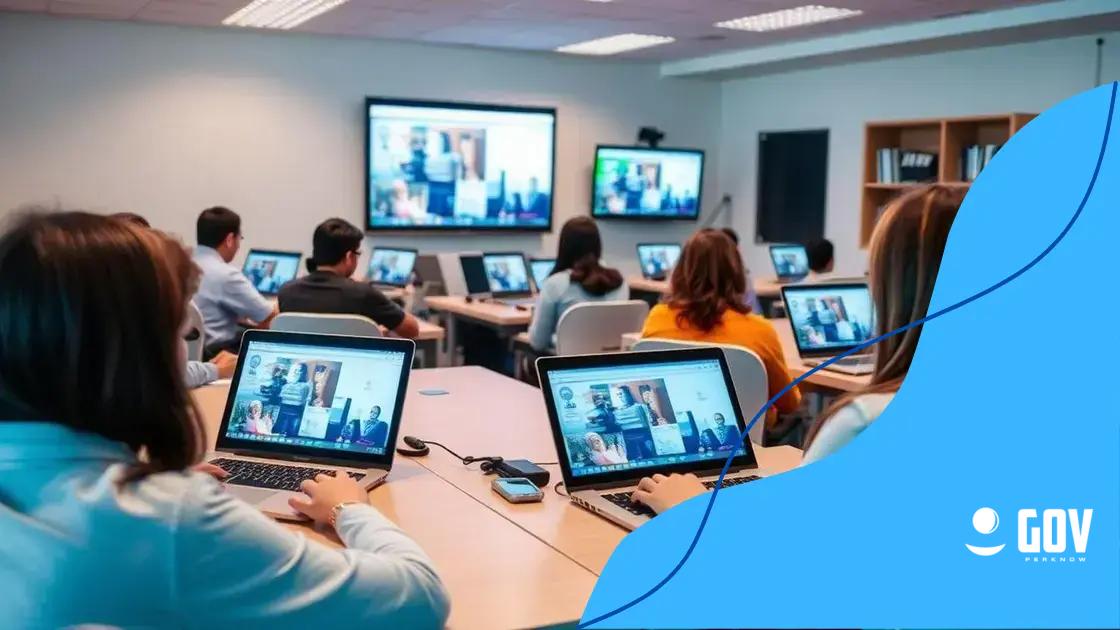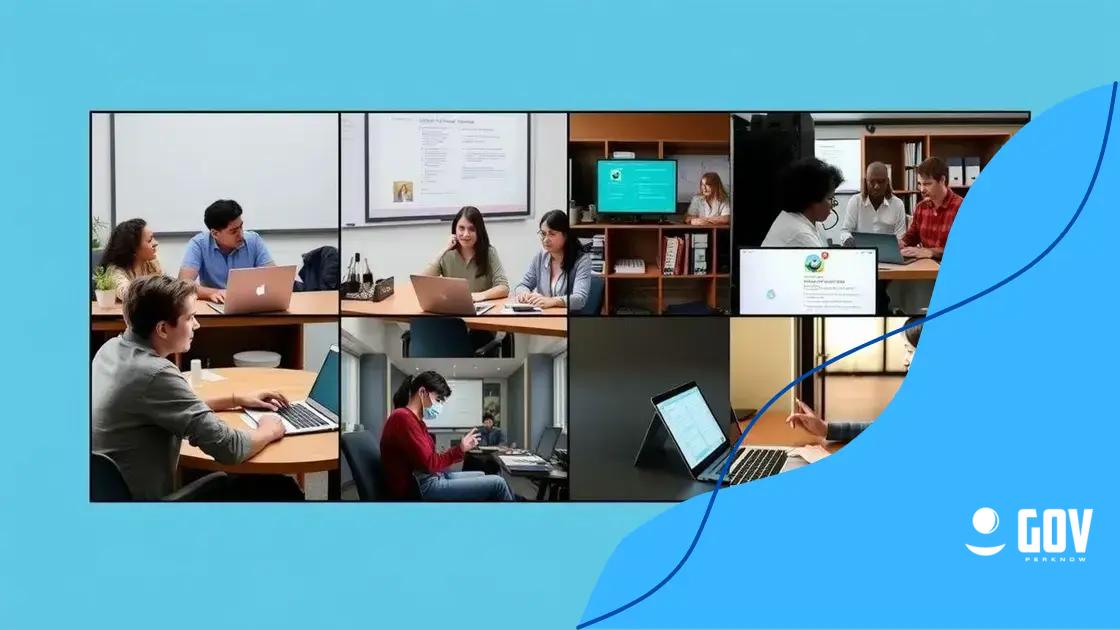Virtual learning standards policy: what you need to know

A virtual learning standards policy outlines essential guidelines to enhance student engagement and academic outcomes through effective curriculum standards, assessment methods, and the integration of innovative technologies like AI and interactive learning.
Virtual learning standards policy is crucial in today’s educational landscape. Have you ever wondered how these guidelines shape the learning experiences of students? Let’s dive into this essential topic and see how it impacts education.
Defining virtual learning standards policy
Defining a virtual learning standards policy is key to ensuring effective online education. This policy provides educators and students with a framework that promotes high-quality learning experiences. It outlines expectations and guidelines for the delivery of education in a virtual environment.
Such policies help schools and institutions set clear goals. They also address the challenges that may arise in online settings. Below are some important aspects to consider:
Key Components
A well-structured virtual learning standards policy includes several critical components that drive its success:
- Clear learning objectives
- Assessment strategies that reflect student learning
- Guidelines for teacher training and support
- Technology requirements and accessibility considerations
These elements should work together harmoniously to enhance the educational experience. When aligned correctly, they contribute to building a robust virtual learning environment where students thrive.
Benefits of Establishing Policies
Implementing a virtual learning standards policy brings numerous benefits. It promotes consistency in teaching methods and resources. Students can expect a certain standard of education regardless of their location. This consistency helps foster an engaging learning atmosphere, where students feel supported and motivated.
Moreover, these policies can improve communication between educators, students, and guardians. Clear channels of communication are essential for addressing concerns and ensuring that students receive timely feedback on their performance. Strong lines of communication can also help build a community around the virtual classroom.
Key components of effective policies
Understanding the key components of effective policies is essential for any virtual learning standards policy. These components work together to create a supportive and successful educational environment. Each piece plays a vital role in ensuring that students and educators have the resources and guidance they need.
Essential Elements
Every effective policy includes several critical elements:
- Curriculum standards: These define what students should learn and achieve.
- Assessment methods: Clear strategies help evaluate student performance.
- Professional development: Ongoing training for teachers is crucial for adapting to new technologies.
- Access and equity: Policies should ensure all students have equal opportunities to succeed.
Incorporating these elements helps create a cohesive plan for virtual learning. The curriculum standards guide the educational content, while assessment methods ensure that students meet their learning goals. Further, professional development enables educators to stay current with teaching practices and technology.
Importance of Communication
Effective policies also emphasize strong communication among all stakeholders. Regular updates and feedback loops keep everyone informed about expectations and progress. This transparent communication fosters collaboration between teachers, students, and parents.
Additionally, a strong policy establishes processes for addressing issues that may arise. When everyone understands their roles and responsibilities, it minimizes confusion and promotes a more effective learning environment.
Impact on student engagement and outcomes

The impact on student engagement and outcomes is a crucial aspect of any virtual learning standards policy. Engaging students effectively can lead to better learning experiences and improved academic performance. As education shifts online, understanding this impact becomes even more important.
Engagement Strategies
Creating engagement in a virtual setting requires innovative strategies. Here are some effective methods:
- Interactive content: Using videos, quizzes, and interactive assignments keeps students interested.
- Collaborative projects: Group work encourages peer-to-peer interaction and builds a sense of community.
- Regular feedback: Providing timely feedback helps students understand their progress.
- Flexible learning paths: Allowing students to choose their own topics can increase motivation.
These strategies can create an environment where students feel more involved in their learning. When students are engaged, they are likely to invest more effort into their studies. This may lead to higher completion rates and overall academic success.
Measuring Outcomes
To assess the impact on student outcomes, schools must utilize various metrics. Standardized tests often measure knowledge, but other factors play a role in success too. Attendance rates, participation in discussions, and the quality of assignments are critical indicators of student engagement and effectiveness.
Furthermore, qualitative data from student surveys can reveal insights about their experiences and satisfaction. Gathering this information allows educational institutions to make informed adjustments to enhance the virtual learning experience.
Best practices for implementation
Implementing a virtual learning standards policy involves several best practices to ensure successful adoption. These practices guide educators and institutions on how to effectively integrate policies into their existing systems. Following these recommendations can lead to a smoother transition and enhance the overall learning experience.
Planning and Preparation
Before launching any virtual learning initiative, thorough planning is essential. This includes setting clear goals for student outcomes and determining the necessary resources. Schools should assess their technology needs and provide adequate training for teachers. By preparing in advance, institutions can mitigate challenges that may arise during implementation.
Professional Development
Ongoing professional development for educators is critical. Teachers need to feel comfortable and confident in using the technology and methodologies associated with the policy. Regular workshops, training sessions, and peer collaboration can help educators adapt effectively to new tools.
Engagement with Stakeholders
Engaging all stakeholders is also vital for the successful implementation of a policy. This includes students, parents, and teachers. Regular communication ensures everyone understands the expectations and objectives. Feedback from these groups can provide valuable insights into how the policy is functioning and what adjustments may be beneficial.
- Identify key stakeholders early in the process.
- Schedule regular updates and feedback sessions.
- Encourage open dialogue about concerns and suggestions.
- Utilize surveys to gather input from the community.
By fostering collaboration and communication, a sense of ownership can develop among stakeholders. This buy-in is essential for encouraging participation and adherence to the policy.
Continuous Evaluation and Adaptation
Finally, continuously evaluate the implemented policy. Collect data on student performance and engagement to identify areas for improvement. Adapting the policy based on real-time feedback ensures that it remains relevant and effective over time. Periodic reviews allow schools to respond proactively to changing needs.
Future trends in virtual learning
The future trends in virtual learning are shaping how education will look in the coming years. As technology continues to evolve, so do the methods we use to educate students online. Staying ahead of these trends is crucial for educators and institutions aiming to offer the best learning experiences.
Increased Use of Artificial Intelligence
One significant trend is the integration of artificial intelligence (AI) into virtual learning environments. AI can personalize learning experiences by adapting to individual student needs. This technology provides tailored resources and feedback based on performance, helping each learner reach their potential more effectively.
Greater Emphasis on Interactive Learning
Another trend is the growing focus on interactive learning methods. Gamification, simulations, and immersive technologies like virtual reality (VR) are becoming more common in online classrooms. These techniques engage students in a way that traditional methods cannot, making learning more enjoyable and effective.
Growing Need for Soft Skills Development
Additionally, there is an increasing recognition of the importance of soft skills in education. Skills such as communication, collaboration, and critical thinking will be emphasized more in virtual learning curricula. Preparing students for the real world requires a balance between academic knowledge and these essential skills.
- Collaborative tools: Platforms like Google Workspace and Microsoft Teams are popular for facilitating teamwork.
- Life-long learning: Continuous education through online platforms is becoming necessary for career advancement.
- Focus on mental health: Programs that support emotional well-being are gaining importance in education.
- Accessibility improvements: Enhancing access to technology for all students is a critical focus area.
As these trends continue to develop, educators must be adaptable. By incorporating innovative teaching methods and technology, they can create more engaging and effective learning environments.
FAQ – Frequently Asked Questions about Virtual Learning Standards Policy
What are the key components of a virtual learning standards policy?
Key components include clear curriculum standards, effective assessment methods, ongoing professional development for educators, and guidelines for accessibility.
How can AI enhance virtual learning?
AI can personalize learning experiences by adapting to individual student needs, providing tailored resources, and offering real-time feedback.
Why is student engagement important in virtual learning?
Student engagement is critical as it leads to better learning experiences, higher completion rates, and improved academic outcomes.
What are some future trends in virtual learning?
Future trends include increased use of AI, greater emphasis on interactive learning, development of soft skills, and a focus on mental health.






